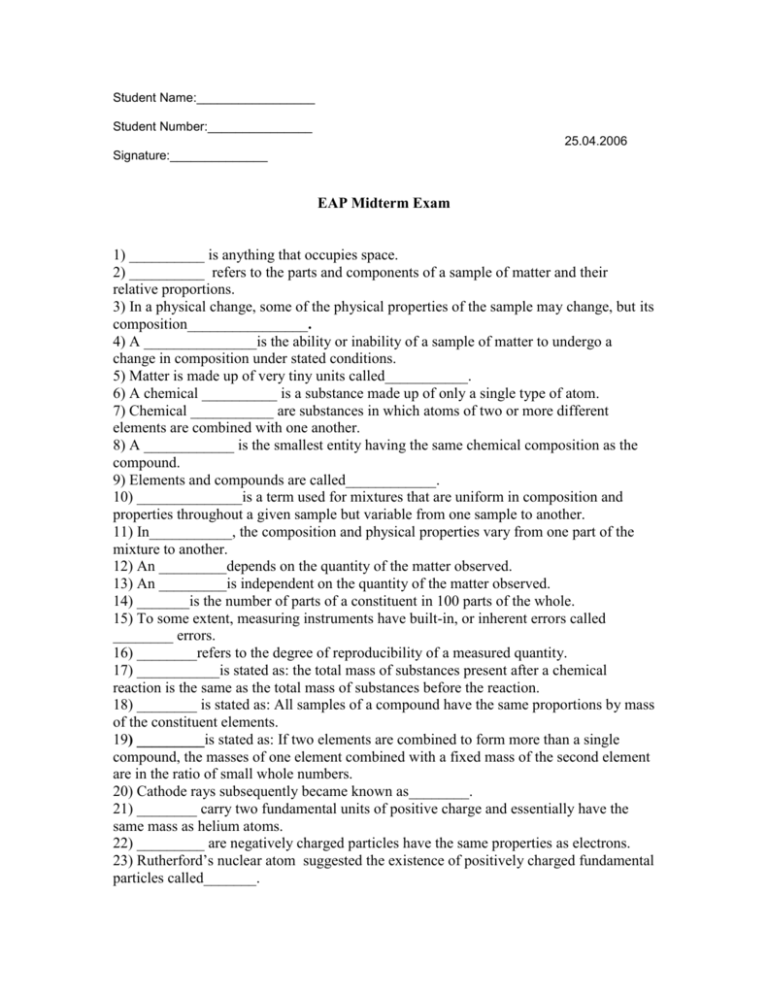Student Name
advertisement

Student Name:_________________ Student Number:_______________ 25.04.2006 Signature:______________ EAP Midterm Exam 1) __________ is anything that occupies space. 2) __________ refers to the parts and components of a sample of matter and their relative proportions. 3) In a physical change, some of the physical properties of the sample may change, but its composition________________. 4) A _______________is the ability or inability of a sample of matter to undergo a change in composition under stated conditions. 5) Matter is made up of very tiny units called___________. 6) A chemical __________ is a substance made up of only a single type of atom. 7) Chemical ___________ are substances in which atoms of two or more different elements are combined with one another. 8) A ____________ is the smallest entity having the same chemical composition as the compound. 9) Elements and compounds are called____________. 10) ______________is a term used for mixtures that are uniform in composition and properties throughout a given sample but variable from one sample to another. 11) In___________, the composition and physical properties vary from one part of the mixture to another. 12) An _________depends on the quantity of the matter observed. 13) An _________is independent on the quantity of the matter observed. 14) _______is the number of parts of a constituent in 100 parts of the whole. 15) To some extent, measuring instruments have built-in, or inherent errors called ________ errors. 16) ________refers to the degree of reproducibility of a measured quantity. 17) ___________is stated as: the total mass of substances present after a chemical reaction is the same as the total mass of substances before the reaction. 18) ________ is stated as: All samples of a compound have the same proportions by mass of the constituent elements. 19) _________is stated as: If two elements are combined to form more than a single compound, the masses of one element combined with a fixed mass of the second element are in the ratio of small whole numbers. 20) Cathode rays subsequently became known as________. 21) ________ carry two fundamental units of positive charge and essentially have the same mass as helium atoms. 22) _________ are negatively charged particles have the same properties as electrons. 23) Rutherford’s nuclear atom suggested the existence of positively charged fundamental particles called_______. 24) The ________is defined as exactly 1/12 of the mass of the atom known as carbon-12. 25) The number of protons in an atom is called the__________. 26) The total number of protons and neutrons in an atom is called the ___________. 27) Atoms that have the same atomic number but different mass numbers are called______. 28) The _______ of an element is the average of the isotopic masses. 29) A ________ is an amount of substance that contains the same number of elementary entities as there carbon-12 atoms in exactly 12 g of carbon-12. 30) __________ is the number of elementary entities in a mole of substance. 31) A __________ is the symbolic representation that indicates the elements present in a compound and their relative number of atoms. 32) An _____________ is the simplest formula for a compound. 33) A ___________shows the order in which atoms are bonded together in a molecule and by what type of bonds. 34) An ______is made up of positive and negative ions joined together by electrostatic forces of attraction. 35) The ______ of an ionic compound is the smallest electrically neutral collection of ions. 36) ________ is the mass of a molecule in atomic mass units. 37) The ________ is the mass of one mole of compound. 38) The ________is related to the number of electrons that an atom gains, loses, or otherwise appears to use in joining with other atoms in compounds. 39) _______ are those formed between two elements. 40) In_______, two or more atoms are joined together by covalent bonds. 1) polyatomic ions 2) intensive property 3) law of conservation of mass 4) substances 5) compounds 6) homogeneous mixture 7) protons 8) atomic number (Z) 9) isotopes 10) structural formula 11) mole 12) extensive property 13) avogardro’s constant 14) alpha particles 15) percent 16) law of definite proportions 17) molar mass 18) chemical formula 19)chemical property 20) atoms 21) systematic 22) beta particles 23) element 24) electrons 25) atomic mass unit 26) mass number (A) 27) atomic mass 28) matter 29)composition 30) remains unchanged 31) empirical formula 32) molecule 33) ionic compound 34) formula unit 35) oxidation number 36) law of multiple proportions 37) precision 38) binary compounds 39) molecular mass 40) heterogeneous mixtures





